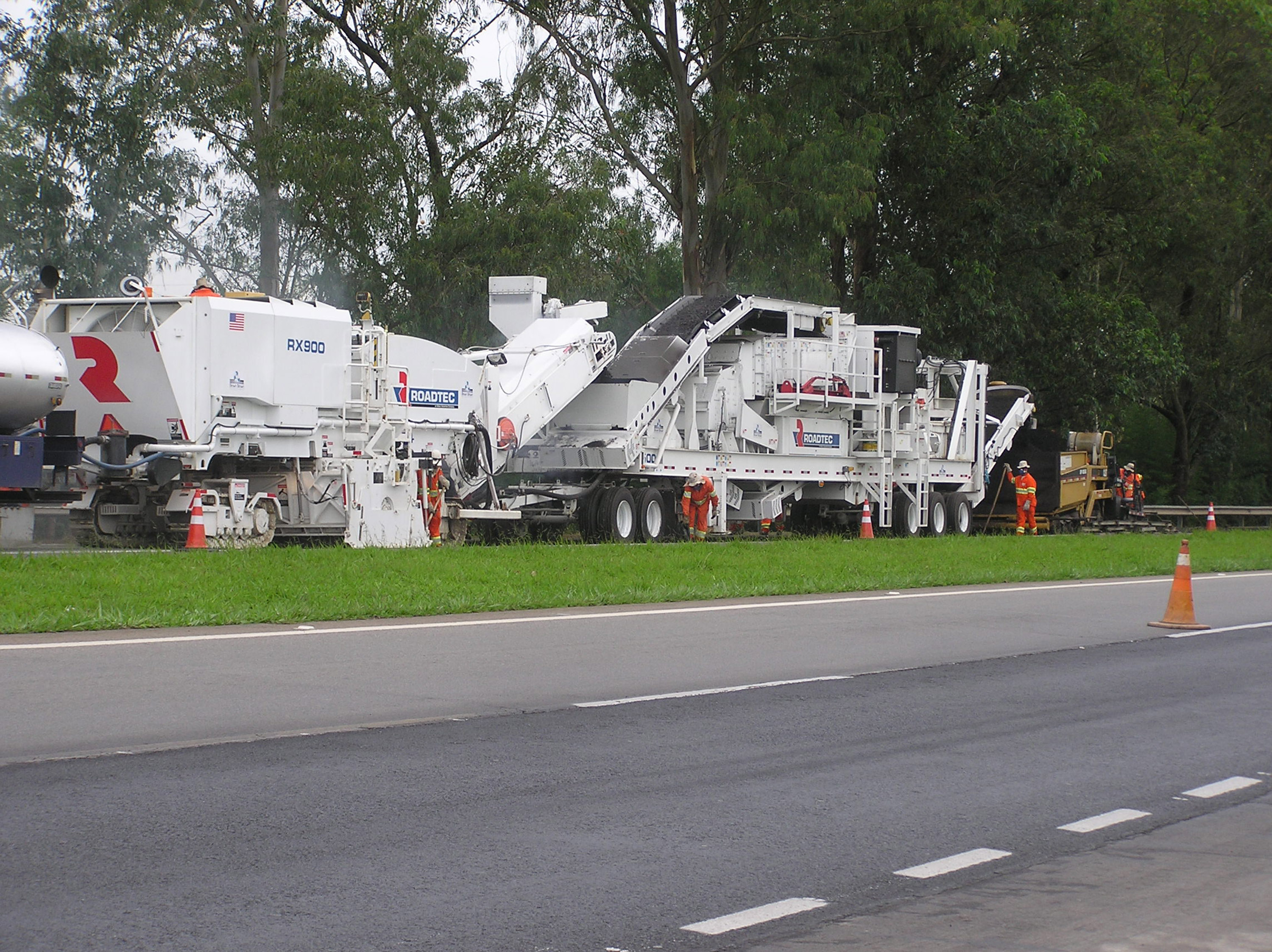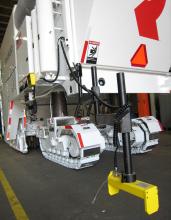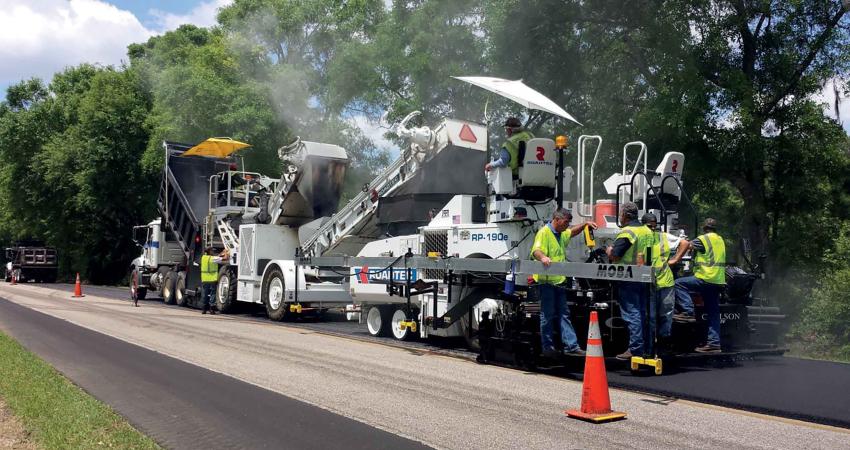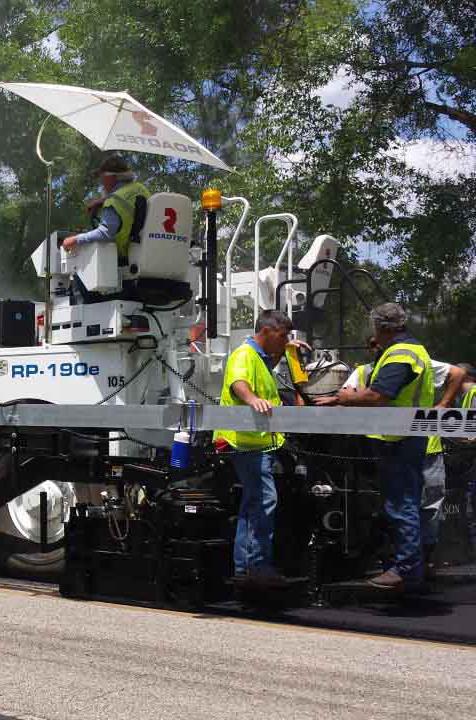Cold-in place recycling method provides fast road rebuild in Brazil In Brazil a road contractor has carried out a high quality road rebuilding job, using novel techniques. Contractor Brown Brown is located in Santa Teresinha in the state of Bahia and recently carried out a two-week job for the company to rehabilitate sections of highway BR-381. The highway is an important route in Brazil and runs from Sao Paulo to Belo Horizonte. Highway BR-381 or Rodovia Fernão Dias, as it is called, stretches some 576km

The road rebuilding method has been developed to meet the needs of the Brazilian market
Cold-in place recycling method provides fast road rebuild in Brazil
In Brazil a road contractor has carried out a high quality road rebuilding job, using novel techniques. Contractor Brown Brown is located in Santa Teresinha in the state of Bahia and recently carried out a two-week job for the company to rehabilitate sections of highway BR-381. The highway is an important route in Brazil and runs from Sao Paulo to Belo Horizonte. Highway BR-381 or Rodovia Fernão Dias, as it is called, stretches some 576km through the Brazilian states of São Paulo and southern and eastern regions of Minas Gerais.
Because HMA costs are very expensive in Brazil, Brown Brown owners Edgardo and Max Lucas have investigated novel road repair methods. Working in conjunction with technical staff from1252 Roadtec, Brown Brown has developed cold in-place recycling (CIR) processes and techniques tailored for the tropical climates and for roadways carrying heavy traffic volumes. Over many years of research and application experience they have improved emulsion chemistry, milled cut surface preparation, CIR plant configuration, paving techniques and pavement compaction to produce a high quality CIR roadway with good surface finish. Brown Brown guarantees its CIR roadwork for eight years.
The cold recycler train start-up for the BR-381 project was located near the city of Pouso Alegre. The two-lane highway has heavy truck traffic. The work is monitored by both Federal and State highway inspectors who closely monitor the process and take test samples of the product to measure emulsion percentage, water content, aggregate size, and other variables. Brown Brown has its own mobile test lab to test its own samples and monitor quality control.
Traffic was diverted to one lane and the speed was posted at 56km/h. The crew worked on both sides of the equipment train, so there was always the safety concern with traffic. The roadwork train consisted of a water truck in front, emulsion tanker truck, Roadtec RX-900e cold planer, Roadtec RT-500 mobile recycle trailer, a178 Caterpillar paver, a Cat twin drum compactor and a Cat rubber tyre roller.
The pairing of the two Roadtec pieces allowed the CIR process, which was essential to the highway BR-381 project. Max Lucas pointed out that the Roadtec RT-500 functioned like a material transfer vehicle by providing a steady flow of RAP material to the paver allowing for continuous, steady production runs, which resulted in smooth pavement. “There were no ripples, rough spots, or dips in the finished road,” Max added.
BR-381 is constructed with fine grain hard granite aggregate, which is a challenge to mill. The contractor used2365 Kennametal teeth, which were replaced every two to three days of operation. The mill typically cut 110mm deep and averaged 9m/min.
Because of the condition of the road being a challenge to mill, several crew members cleaned the sides of the cut with shovels and brooms. If the side of the cut cracked from the mill side guides, then the crew would break and remove the cracked material. As the crew working on the passenger side of the road cleaned the area, the loose material was deposited on the side of the road. The crew on the driver’s side deposited the loose material in piles located in the centre of the cut.
A mixture of emulsion and water is poured on the sides and top of the milled road edges to bond and seal the cold asphalt. One crew member is responsible for operation of the Roadtec RT-500. This worker would adjust the emulsion and water additive percentages for the proper mixture based on the current roadway moisture content, evaporation rate and weather conditions.
They also adjust the end delivery conveyor position. Typically more cold asphalt is generated than is required for the roadway, so at times the end delivery conveyor is pivoted to discharge on the side of the road or into the loader bucket.
The emulsion percentage was adjusted from 2.8-3.5% and the water was adjusted from 1.8-3.5% during operation. Edgardo Lucas commented that during hot days the water requirements can go as high as 4.5%.
Workers stationed between the RT-500 and the paver scrape the cut surface using large flat-plate hoes and shovels to remove the loose material. The piles from the driver’s side crew near the RX-900 milling machine are also removed at this point.
Brown Brown had modified the paver hopper to add capacity and installed sloped diverters in the hopper corners to help prevent material build-up. The paver hopper was kept full of material to add weight to the paver to improve the stability of the screed.
The screed was set with a slight incline on the leading edge to push down on the cold asphalt generating a smooth surface. The centre augers on the paver were switched to convey inward to prevent centreline separation. This finessing worked well with no visible signs of centreline separation.
The twin drum roller followed closely behind the paver due to the fast breaking emulsion, with the rubber tyred compactor providing final compaction. Each compactor made six passes without using vibration. As the Lucas brothers look back on the finished roadway, they credit the CIR system as being instrumental in the quality achieved. “The advantage of this style of CIR plant is that material from the pugmill is directly deposited into the paver, which appears to help generate an improved surface finish on the new pavement,” added Mike Fischer, Roadtec field service technician.
In Brazil a road contractor has carried out a high quality road rebuilding job, using novel techniques. Contractor Brown Brown is located in Santa Teresinha in the state of Bahia and recently carried out a two-week job for the company to rehabilitate sections of highway BR-381. The highway is an important route in Brazil and runs from Sao Paulo to Belo Horizonte. Highway BR-381 or Rodovia Fernão Dias, as it is called, stretches some 576km through the Brazilian states of São Paulo and southern and eastern regions of Minas Gerais.
Because HMA costs are very expensive in Brazil, Brown Brown owners Edgardo and Max Lucas have investigated novel road repair methods. Working in conjunction with technical staff from
The cold recycler train start-up for the BR-381 project was located near the city of Pouso Alegre. The two-lane highway has heavy truck traffic. The work is monitored by both Federal and State highway inspectors who closely monitor the process and take test samples of the product to measure emulsion percentage, water content, aggregate size, and other variables. Brown Brown has its own mobile test lab to test its own samples and monitor quality control.
Traffic was diverted to one lane and the speed was posted at 56km/h. The crew worked on both sides of the equipment train, so there was always the safety concern with traffic. The roadwork train consisted of a water truck in front, emulsion tanker truck, Roadtec RX-900e cold planer, Roadtec RT-500 mobile recycle trailer, a
The pairing of the two Roadtec pieces allowed the CIR process, which was essential to the highway BR-381 project. Max Lucas pointed out that the Roadtec RT-500 functioned like a material transfer vehicle by providing a steady flow of RAP material to the paver allowing for continuous, steady production runs, which resulted in smooth pavement. “There were no ripples, rough spots, or dips in the finished road,” Max added.
BR-381 is constructed with fine grain hard granite aggregate, which is a challenge to mill. The contractor used
Because of the condition of the road being a challenge to mill, several crew members cleaned the sides of the cut with shovels and brooms. If the side of the cut cracked from the mill side guides, then the crew would break and remove the cracked material. As the crew working on the passenger side of the road cleaned the area, the loose material was deposited on the side of the road. The crew on the driver’s side deposited the loose material in piles located in the centre of the cut.
A mixture of emulsion and water is poured on the sides and top of the milled road edges to bond and seal the cold asphalt. One crew member is responsible for operation of the Roadtec RT-500. This worker would adjust the emulsion and water additive percentages for the proper mixture based on the current roadway moisture content, evaporation rate and weather conditions.
They also adjust the end delivery conveyor position. Typically more cold asphalt is generated than is required for the roadway, so at times the end delivery conveyor is pivoted to discharge on the side of the road or into the loader bucket.
The emulsion percentage was adjusted from 2.8-3.5% and the water was adjusted from 1.8-3.5% during operation. Edgardo Lucas commented that during hot days the water requirements can go as high as 4.5%.
Workers stationed between the RT-500 and the paver scrape the cut surface using large flat-plate hoes and shovels to remove the loose material. The piles from the driver’s side crew near the RX-900 milling machine are also removed at this point.
Brown Brown had modified the paver hopper to add capacity and installed sloped diverters in the hopper corners to help prevent material build-up. The paver hopper was kept full of material to add weight to the paver to improve the stability of the screed.
The screed was set with a slight incline on the leading edge to push down on the cold asphalt generating a smooth surface. The centre augers on the paver were switched to convey inward to prevent centreline separation. This finessing worked well with no visible signs of centreline separation.
The twin drum roller followed closely behind the paver due to the fast breaking emulsion, with the rubber tyred compactor providing final compaction. Each compactor made six passes without using vibration. As the Lucas brothers look back on the finished roadway, they credit the CIR system as being instrumental in the quality achieved. “The advantage of this style of CIR plant is that material from the pugmill is directly deposited into the paver, which appears to help generate an improved surface finish on the new pavement,” added Mike Fischer, Roadtec field service technician.










